PORSCHE 911 CARRERA 2013 6.G Information Manual
Manufacturer: PORSCHE, Model Year: 2013, Model line: 911 CARRERA, Model: PORSCHE 911 CARRERA 2013 6.GPages: 76, PDF Size: 11.32 MB
Page 31 of 76
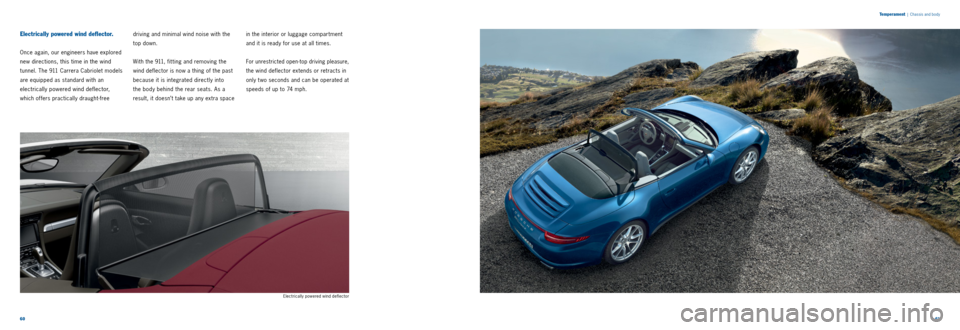
6061
Electrically powered wind deflector.
Once again, our engineers have explored
new directions, this time in the wind
tunnel. The 911 Carrera Cabriolet models
are equipped as standard with an
electrically powered wind deflector,
which offers practically draught free driving and minimal wind noise with the
top down.
With the 911, fit ting and removing the
wind deflector is now a thing of the past
because it is integrated directly into
the body behind the rear seats. As a
result, it doesn’t take up any extra space in the interior or luggage compartment
and it is ready for use at all times.
For unrestricted open
top driving pleasure,
the wind deflector extends or retracts in
only t wo seconds and can be operated at
speeds of up to 74 mph.
T emperament | Chassis and body
Electrically powered wind deflector
Page 32 of 76
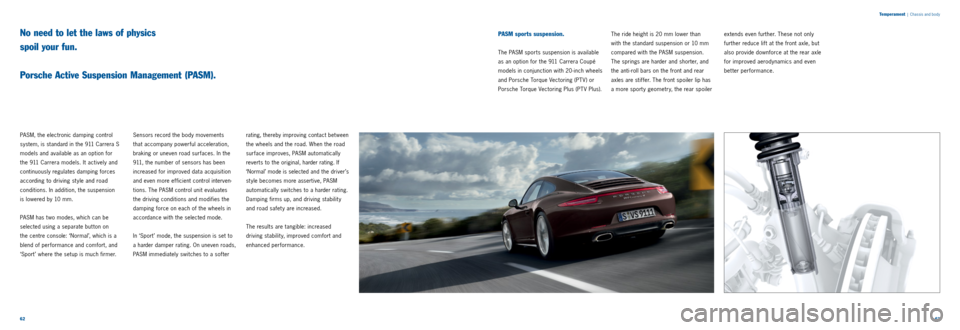
6263
Temperament
| Chassis and body
PASM, the electronic damping control
system, is standard in the 911 Carrera S
models and available as an option for
the 911 Carrera models. It actively and
continuously regulates damping forces
according to driving st yle and road
conditions. In addition, the suspension
is lowered by 10 mm.
PASM has t wo modes, which can be
selected using a separate but ton on
the centre console: ‘Normal’, which is a
blend of performance and comfort, and
‘Sport ’ where the setup is much firmer. Sensors record the body movements
that accompany powerful acceleration,
braking or uneven road surfaces. In the
911, the number of sensors has been
increased for improved data acquisition
and even more ef ficient control interven
tions. The PASM control unit evaluates
the driving conditions and modifies the
damping force on each of the wheels in
accordance with the selected mode.
In ‘Sport ’ mode, the suspension is set to
a harder damper rating. On uneven roads,
PASM immediately switches to a softer
rating, thereby improving contact between
the wheels and the road. When the road
surface improves, PASM automatically
reverts to the original, harder rating. If
‘Normal’ mode is selected and the driver’s
st yle becomes more assertive, PASM
automatically switches to a harder rating.
Damping firms up, and driving stability
and road safet y are increased.
The results are tangible: increased
driving stability, improved comfort and
enhanced performance.
No need to let the laws of physics
spoil your fun.
Porsche Active Suspension Management (PASM).PASM sports suspension.
The PASM sports suspension is available
as an option for the 911 Carrera Coupé
models in conjunction with 20 inch wheels
and Porsche Torque Vectoring (PTV) or
Porsche Torque Vectoring Plus (PTV Plus). The ride height is 20 mm lower than
with the standard suspension or 10 mm
compared with the PASM suspension.
The springs are harder and shorter, and
the anti roll bars on the front and rear
axles are stiffer. The front spoiler lip has
a more sport y geometry, the rear spoiler extends even further. These not only
further reduce lift at the front axle, but
also provide downforce at the rear axle
for improved aerodynamics and even
better performance.
Page 33 of 76

6465
Temperament
| Chassis and body
It ’s easy, and even makes sense, to carry
on in your usual way, but what happens
if a sudden change of direction leaves
you thrown off course? Then, it all comes
down to personal strength.
A Porsche has a clear sense of purpose
and is the embodiment of strength. It
demonstrates this with sport y and precise
handling and excellent road holding.
With the optional Porsche Dynamic
Chassis Control (PDCC) for the S models
of the 911 Carrera, these characteristics
can be further accentuated: the vehicle
holds the road even bet ter and delivers
even sportier performance. PDCC is an active anti
roll system that
suppresses lateral body movement during
cornering manoeuvres. In addition, it
minimises the lateral instability of the
vehicle on uneven ground.
This effect is achieved with the aid of
hydraulic stabilising actuators in the form
of cylinders designed to optimise camber.
Lateral roll is counteracted by forces
generated at each individual wheel, based
on steering angle and lateral acceleration.
Rapid cornering in the 911 Carrera without PDCC (illustrative example) Rapid cornering in the 911 Carrera S with PDCC (illustrative example)
You appreciate directness.
But love a few twists and turns.
Porsche Dynamic Chassis Control (PDCC).The results are improved dynamic perfor
mance and increased ride comfort at all
speeds, as well as optimised turn in and
stable load transfer characteristics.
In simple terms, the t yres and vehicle
hold the road bet ter and you can steer
through corners faster and in a more
re l a x e d m a n n e r.
PDCC sets standards for handling perfor
mance, ride comfort and driving
pleas
ure. In the 911, your ‘usual’ way suddenly
becomes the Porsche way.
Page 34 of 76
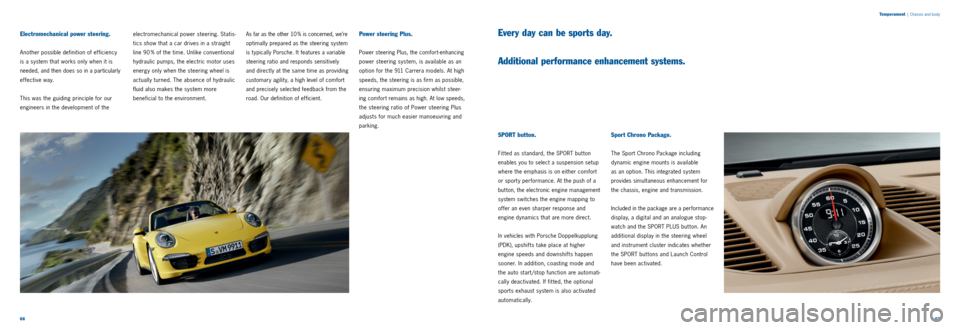
6667
Temperament
| Chassis and body
Electromechanical power steering.
Another possible definition of efficiency
is a system that works only when it is
needed, and then does so in a particularly
effective way.
This was the guiding principle for our
engineers in the development of the electromechanical power steering. Statis
tics show that a car drives in a straight
line 90 % of the time. Unlike conventional
hydraulic pumps, the electric motor uses
energy only when the steering wheel is
actually turned. The absence of hydraulic
fluid also makes the system more
bene ficial to the environment.
As far as the other 10 % is concerned, we’re
optimally prepared as the steering system
is t ypically Porsche. It features a variable
steering ratio and responds sensitively
and directly at the same time as providing
customary agility, a high level of comfort
and precisely selected feedback from the
road. Our definition of efficient.Power steering Plus.
Power steering Plus, the comfort enhancing
power steering system, is available as an
option for the 911 Carrera models. At high
speeds, the steering is as firm as possible,
ensuring maximum precision whilst steer
ing comfort remains as high. At low speeds,
the
steering ratio of Power steering Plus
adjusts for much easier manoeuvring and
parking.
SPORT button.
Fit ted as standard, the SPORT button
enables you to select a suspension setup
where the emphasis is on either comfort
or sport y performance. At the push of a
button, the electronic engine management
system switches the engine mapping to
offer an even sharper response and
engine dynamics that are more direct.
In vehicles with Porsche Doppelkupplung
(PDK), upshifts take place at higher
engine speeds and downshifts happen
sooner. In addition, coasting mode and
the auto start/stop function are automati
cally deactivated. If fitted, the optional
sports exhaust system is also activated
automatically.
Sport Chrono Package.
The Sport Chrono Package including
dynamic engine mounts is available
as an option. This integrated system
provides simultaneous enhancement for
the chassis, engine and transmission.
Included in the package are a performance
display, a digital and an analogue stop
watch and the SPORT PLUS but ton. An
additional display in the steering wheel
and instrument cluster indicates whether
the SPORT but tons and Launch Control
have been activated.
Every day can be sports day.
Additional performance enhancement systems.
Page 35 of 76
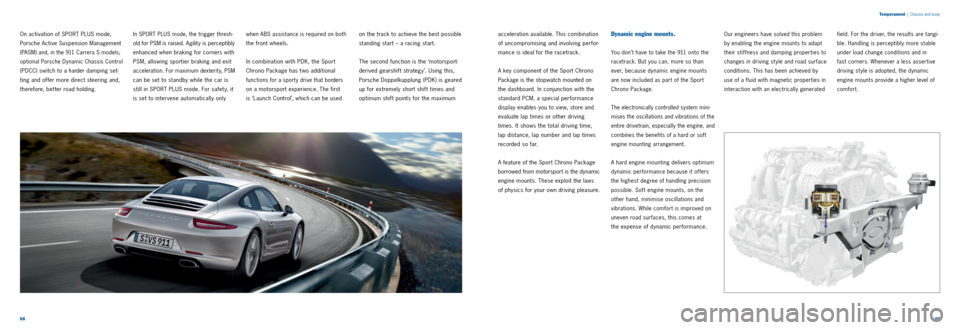
6869
Temperament
| Chassis and body
On activation of SPORT PLUS mode,
Porsche Active Suspension Management
(PASM) and, in the 911 Carrera S models,
optional Porsche Dynamic Chassis Control
(PDCC) switch to a harder damping set
ting and offer more direct steering and,
therefore, better road holding.
In SPORT PLUS mode, the trigger thresh
old for PSM is raised. Agilit y is perceptibly
enhanced when braking for corners with
PSM, allowing sportier braking and exit
acceleration. For maximum dexterit y, PSM
can be set to standby while the car is
still in SPORT PLUS mode. For safet y, it
is set to intervene automatically only
when ABS assistance is required on both
the front wheels.
In combination with PDK, the Sport
Chrono Package has t wo additional
functions for a sport y drive that borders
on a motorsport experience. The first
is ‘Launch Control’, which can be used on the track to achieve the best possible
standing start – a racing start.
The second function is the ‘motorsport
derived gearshif t strategy’. Using this,
Porsche Doppelkupplung (PDK) is geared
up for extremely short shift times and
optimum shift points for the maximum acceleration available. This combination
of uncompromising and involving perfor
mance is ideal for the racetrack.
A key component of the Sport Chrono
Package is the stopwatch mounted on
the dashboard. In conjunction with the
standard PCM, a special performance
display enables you to view, store and
evaluate lap times or other driving
times. It shows the total driving time,
lap distance, lap number and lap times
re c o rde d s o f a r.
A feature of the Sport Chrono Package
borrowed from motorsport is the dynamic
engine mounts. These exploit the laws
of physics for your own driving pleasure.
Dynamic engine mounts.
You don’t have to take the 911 onto the
racetrack. But you can, more so than
ever, because dynamic engine mounts
are now included as part of the Sport
Chrono Package.
The electronically controlled system mini
mises the oscillations and vibrations of the
entire drivetrain, especially the engine, and
combines the benefits of a hard or soft
engine mounting arrangement.
A hard engine mounting delivers optimum
dynamic performance because it offers
the highest degree of handling precision
possible. Soft engine mounts, on the
other hand, minimise oscillations and
vibrations. While comfort is improved on
uneven road surfaces, this comes at
the expense of dynamic performance.
Our engineers have solved this problem
by enabling the engine mounts to adapt
their stiffness and damping properties to
changes in driving st yle and road surface
conditions. This has been achieved by
use of a fluid with magnetic properties in
interaction with an electrically generated field. For the driver, the results are tangi
ble. Handling is perceptibly more stable
under load change conditions and in
fast corners. Whenever a less assertive
driving st yle is adopted, the dynamic
engine mounts provide a higher level of
comfort.
Page 36 of 76
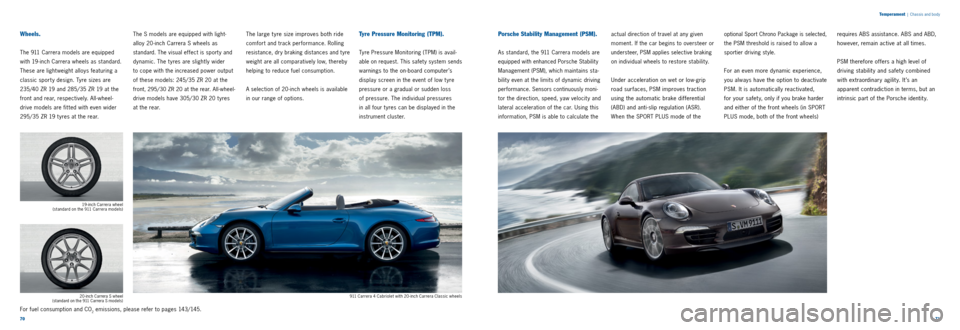
7071
Wheels.
The 911 Carrera models are equipped
with 19inch Carrera wheels as standard.
These are light weight alloys featuring a
classic sport y design. Tyre sizes are
235/40 ZR 19 and 285/35 ZR 19 at the
front and rear, respectively. All wheel
drive models are fit ted with even wider
295/35 ZR 19 t yres at the rear. The S models are equipped with light
alloy 20inch Carrera S wheels as
standard. The visual effect is sport y and
dynamic. The t yres are slightly wider
to cope with the increased power output
of these models: 245/35 ZR 20 at the
front, 295/30 ZR 20 at the rear. All wheel
drive models have 305/30 ZR 20 t yres
at the rear.
The large t yre size improves both ride
comfort and track performance. Rolling
resistance, dry braking distances and t yre
weight are all comparatively low, thereby
helping to reduce fuel consumption.
A selection of 20 inch wheels is available
in our range of options.Tyre Pressure Monitoring (TPM).
Tyre Pressure Monitoring (TPM) is avail
able on request. This safet y system sends
warnings to the on board computer’s
display screen in the event of low t yre
pressure or a gradual or sudden loss
of pressure. The individual pressures
in all four t yres can be displayed in the
instrument cluster.
Porsche Stability Management (PSM).
As standard, the 911 Carrera models are
equipped with enhanced Porsche Stability
Management (PSM), which maintains sta
bilit y even at the limits of dynamic driving
performance. Sensors continuously moni
tor the direction, speed, yaw velocit y and
lateral acceleration of the car. Using this
information, PSM is able to calculate the actual direction of travel at any given
moment. If the car begins to oversteer or
understeer, PSM applies selective braking
on individual wheels to restore stabilit y.
Under acceleration on wet or low grip
road surfaces, PSM improves traction
using the automatic brake differential
(ABD) and anti slip regulation (ASR).
When the SPORT PLUS mode of the
optional Sport Chrono Package is selected,
the PSM threshold is raised to allow a
sportier driving st yle.
For an even more dynamic experience,
you always have the option to deactivate
PSM. It is automatically reactivated,
for your safet y, only if you brake harder
and either of the front wheels (in SPORT
PLUS mode, both of the front wheels) requires ABS assistance. ABS and ABD,
however, remain active at all times.
PSM therefore offers a high level of
driving stability and safety combined
with extraordinary agilit y. It ’s an
apparent contradiction in terms, but an
intrinsic part of the Porsche identit y.
19
inch Carrera wheel
(standard on the 911 Carrera models)
20 inch Carrera S wheel
(standard on the 911 Carrera S models)911 Carrera 4 Cabriolet with 20 inch Carrera Classic wheels
Temperament | Chassis and body
For fuel consumption and CO2 emissions, please refer to pages 143/145.
Page 37 of 76
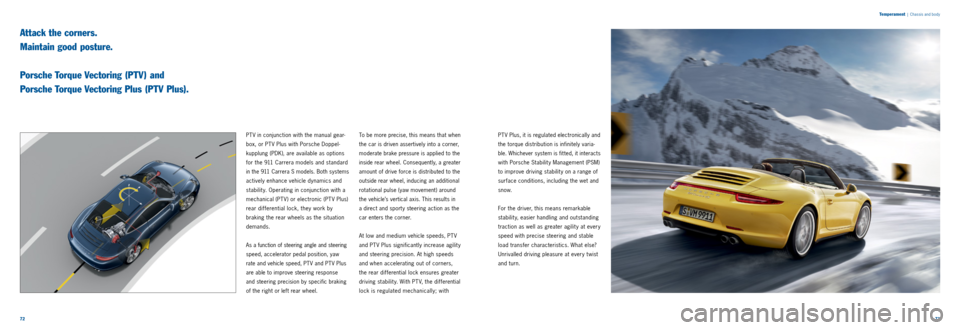
7273
Temperament
| Chassis and body
PTV in conjunction with the manual gear
box, or PT V Plus with Porsche Doppel
kupplung (PDK), are available as options
for the 911 Carrera models and standard
in the 9 11 Carrera S models. Both systems
actively enhance vehicle dynamics and
stability. Operating in conjunction with a
mechanical (PT V) or electronic (PT V Plus)
rear differential lock, they work by
braking the rear wheels as the situation
demands.
As a function of steering angle and steering
speed, accelerator pedal position, yaw
rate and vehicle speed, PT V and PT V Plus
are able to improve steering response
and steering precision by specific braking
of the right or left rear wheel. To be more precise, this means that when
the car is driven assertively into a corner,
moderate brake pressure is applied to the
inside rear wheel. Consequently, a greater
amount of drive force is distributed to the
outside rear wheel, inducing an additional
rotational pulse (yaw movement) around
the vehicle’s vertical axis. This results in
a direct and sport y steering action as the
car enters the corner.
At low and medium vehicle speeds, PT V
and PT V Plus significantly increase agilit y
and steering precision. At high speeds
and when accelerating out of corners,
the rear differential lock ensures greater
driving stability. With PTV, the differential
lock is regulated mechanically; with
Attack the corners.
Maintain good posture.
Porsche Torque Vectoring (PTV) and
Porsche Torque Vectoring Plus (PTV Plus).
PT V Plus, it is regulated electronically and
the torque distribution is infinitely varia
ble. Whichever system is fit ted, it interacts
with Porsche Stabilit y Management (PSM)
to improve driving stabilit y on a range of
surface conditions, including the wet and
snow.
For the driver, this means remarkable
stability, easier handling and outstanding
traction as well as greater agilit y at every
speed with precise steering and stable
load transfer characteristics. What else?
Unrivalled driving pleasure at every t wist
and turn.
Page 38 of 76
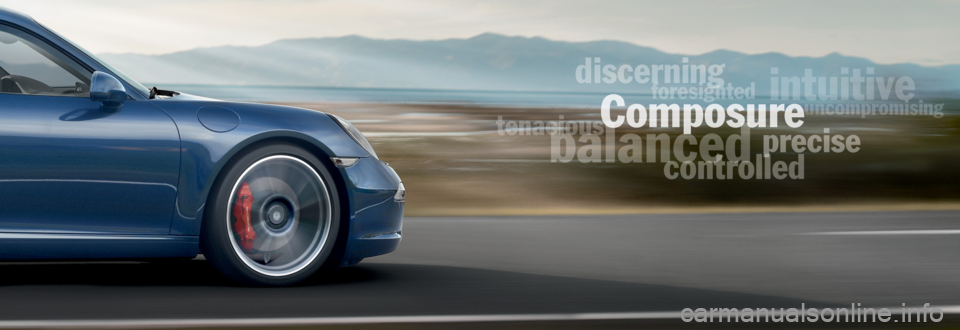
dis
tenacious
precise
controlled
balanced
i
fore
uncompromisi
Composure
Page 39 of 76
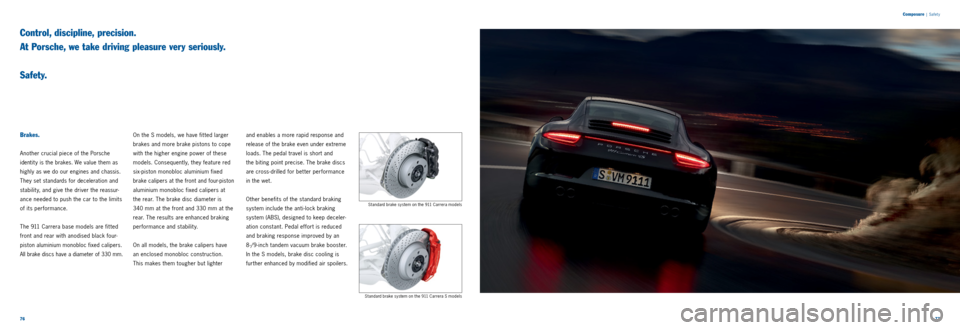
7677
Composure
| Safet y
Control, discipline, precision.
At Porsche, we take driving pleasure very seriously.
S a f e t y.
Brakes.
Another crucial piece of the Porsche
identit y is the brakes. We value them as
highly as we do our engines and chassis.
They set standards for deceleration and
stabilit y, and give the driver the reassur
ance needed to push the car to the limits
of its performance.
The 911 Carrera base models are fit ted
front and rear with anodised black four
piston aluminium monobloc fixed calipers.
All brake discs have a diameter of 330 mm.
On the S models, we have fit ted larger
brakes and more brake pistons to cope
with the higher engine power of these
models. Consequently, they feature red
sixpiston monobloc aluminium fixed
brake calipers at the front and four piston
aluminium monobloc fixed calipers at
the rear. The brake disc diameter is
340 mm at the front and 330 mm at the
rear. The results are enhanced braking
performance and stability.
On all models, the brake calipers have
an enclosed monobloc construction.
This makes them tougher but lighter and enables a more rapid response and
release of the brake even under extreme
loads. The pedal travel is short and
the biting point precise. The brake discs
are cross drilled for better performance
in the wet.
Other benefits of the standard braking
system include the anti lock braking
system (ABS), designed to keep deceler
ation constant. Pedal effort is reduced
and braking response improved by an
8 /9 inch tandem vacuum brake booster.
In the S models, brake disc cooling is
further enhanced by modified air spoilers.
Standard brake system on the 911 Carrera models
Standard brake system on the 911 Carrera S models
Page 40 of 76
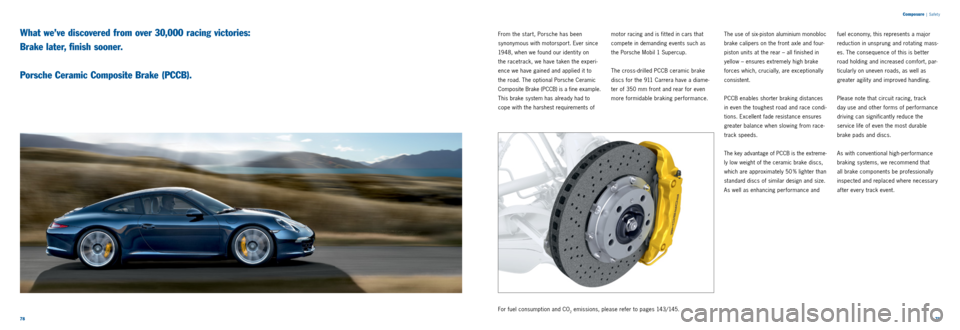
7879
From the start, Porsche has been
synonymous with motorsport. Ever since
1948, when we found our identit y on
the racetrack, we have taken the experi
ence we have gained and applied it to
the road. The optional Porsche Ceramic
Composite Brake (PCCB) is a fine example.
This brake system has already had to
cope with the harshest requirements of
Composure | Safet y
motor racing and is fit ted in cars that
compete in demanding events such as
the Porsche Mobil 1 Supercup.
The cross drilled PCCB ceramic brake
discs for the 911 Carrera have a diame
ter of 350 mm front and rear for even
more formidable braking performance. What we’ve discovered from over 30,000 racing victories:
Brake later, finish sooner.
Porsche Ceramic Composite Brake (PCCB).The use of six piston aluminium monobloc
brake calipers on the front axle and four
piston units at the rear – all finished in
yellow – ensures extremely high brake
forces which, crucially, are exceptionally
consistent.
PCCB enables shorter braking distances
in even the toughest road and race condi
tions. Excellent fade resistance ensures
greater balance when slowing from race
track speeds.
The key advantage of PCCB is the extreme
ly low weight of the ceramic brake
discs,
which are approximately 50 % lighter than
standard discs of similar design and size.
As well as enhancing performance and fuel economy, this represents a major
reduction in unsprung and rotating mass
es. The consequence of this is bet ter
road holding and increased comfort, par
ticularly on uneven roads, as well as
greater agility and improved handling.
Please note that circuit racing, track
day use and other forms of performance
driving can significantly reduce the
service life of even the most durable
brake pads and discs.
As with conventional high performance
braking systems, we recommend that
all brake components be professionally
inspected and replaced where necessary
after every track event.
For fuel consumption and CO
2 emissions, please refer to pages 143/145.